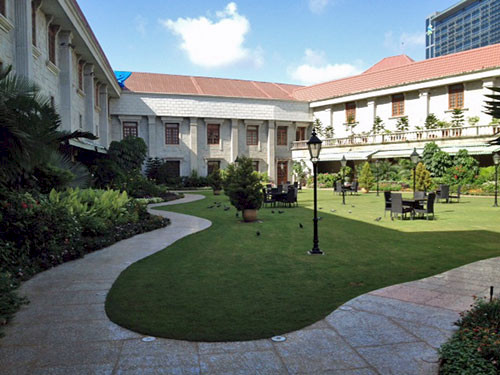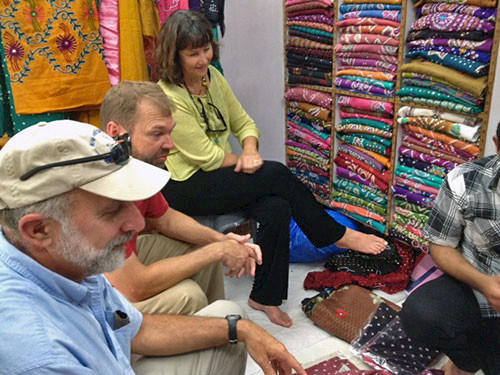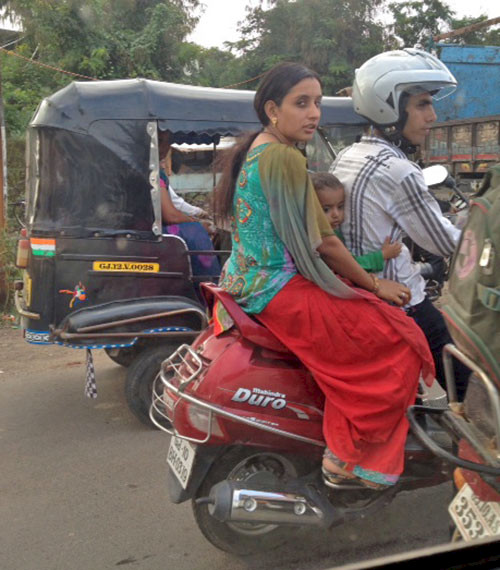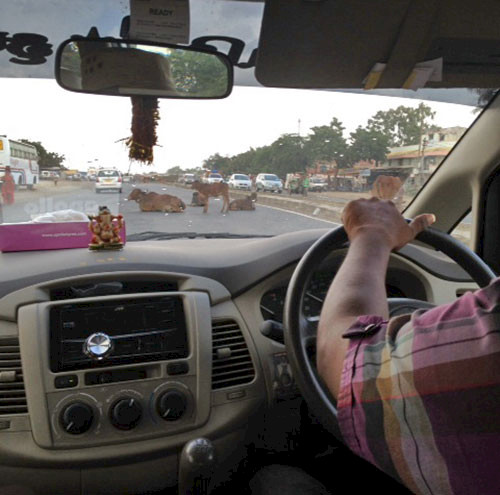Sights and sounds of India
Bill Dennison ·This was my first trip to the subcontinent so everything was new to me. The stopover in Mumbai (Bombay) was my first encounter with the traffic, noise, smells and crowds of people. The airport is surrounded by dense housing, much of which includes blue tarps and corrugated iron as roofing and walls. I could smell the masses of people, even in the airport. The traffic is amazing, with a majority of people on motorbikes and small cars, but also trucks, bicycles, buses and little motorized 'rickshaw' taxis weaving and passing in a fluid mass, not unlike a flock of birds. With only inches to spare, we would pass other vehicles and the cows wandering in the middle of the street, somehow avoiding each other. I resolved that I will never drive in India - it would be too nerve-racking.
We stayed at the Bombay Cricket Club, also known as the Mumbai Cricket Association, a beautiful facility not far from the airport. I recognized a former international cricket player using the facility, but the world's best player Sachin Tendulkar, a frequent visitor, was not in attendance. The immaculate gardens, wonderful food, Bombay Gin and Tonics, and beautiful teak woodwork were reminiscent of a time when travel to exotic lands was a first class experience.

We visited the Gateway to India, a popular tourist destination, and also a popular urban beach where families had picnics and swam in the warm Arabian Sea. Our tour guide was Ajay Ray, an engineer who had been living in Mumbai and recently joined the National Centre for Sustainable Coastal Management, so he was very knowledgeable. He also helped deflect the ubiquitous beggars who approached us on the streets or knocked on the car windows at traffic lights. Ajay also taught us how to eat Indian food, tearing off pieces of naan bread to form a scoop to grab the various delicious marsalas and other dishes. In addition, we learned how to eat the lentil soup (dahl) and rice combination which is a major protein source for the largely vegetarian Indian diet.
In Jamnagar, Purvaja Ramachandran and Ramesh Ramachandran (no relation) took us shopping for some clothes and tablecloths which was an interesting experience. We took off our shoes upon entering a store that was stacked floor to ceiling with colorful tie-dyed cloth. It was a family affair with multiple generations of people forming a bucket brigade to show us literally hundreds of designs and fabric cuts. We had a strong, sweet tea from a passing street vendor and then our hosts launched into a long bartering session with the shop owner. After my purchases, I joined the waiting drivers and they showed me how they prepared their small pouches of betel nut leaves for chewing.

The drive between Jamnagar and Ahmenabad gave us an opportunity to view the countryside. Multiple people riding on motorbikes was common. The women wearing saris sat sidesaddle on the back of the motorbike, often with a child sandwiched between her and the driver. The rickshaw taxis were often densely packed with an amazing number of people. We joked that if they used High Occupancy Vehicle (HOV) lanes, that it would need to be HOV-10. We saw oxen pulling plows, camels pulling carts, and people hand weeding the fields. There were many small roadside stands that sold a dizzying variety of food, clothes and household goods.

The visit to the Gugarat Ecological and Education and Research Foundation nature park and zoo was particularly interesting. The huge crane named Jimmy that came running up with his handler and proceeded to make a evocative mating call was particularly impressive. The roaring tiger was amazing, and the wild lion-tailed monkeys dashing through the trees overhead were intriguing. The fossilized dinosaur eggs and footprints were presented next to life sized outdoor dinosaur models. The groups of uniformed school children holding hands were very cute.

Overall, India was a sensory overload. The food was spicy and tasty, colors were bright and varied, the noises of honking cars and motorbikes were loud and constant, and the fragrant aromas and sometimes smelly odors very pungent. I can see the attraction to meditation and yoga to reduce the sensory overload. The people that we encountered were polite, friendly and intelligent. English is a second language for most people, and they were at least bilingual, but often multi-lingual. We are looking forward to our next encounter with our Indian colleagues for another dose of the full treatment of Indian hospitality.

About the author
Bill Dennison

Dr. Bill Dennison is a Professor of Marine Science and Vice President for Science Application at the University of Maryland Center for Environmental Science.

